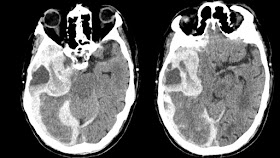Blood-fluid level or hematocrit level or 'Sedimentation level' in spontaneous parenchymal hemorrhage could be due to coagulopathy or when the patient is on anti-coagulation medications. It can also be seen less often in cases of AVM or tumoral bleed (both primary and metastatic), Amyloid Angiopathy and sometimes in Radiation Induced Necrosis.
Approximately 60% of patients with increased PT/APTT can have blood-fluid levels in intracranial hemorrhages as per the reference below. 'Fluid-blood levels in acute intracerebral hemorrhage are moderately sensitive to the presence of coagulopathy (ie, abnormal prothrombin time and partial thromboplastin time) and highly specific for this condition. Thus, an intracerebral hemorrhage with a fluid-blood level should prompt a thorough search for coagulopathy because early treatment of this condition may improve the 40% mortality in these patients'.
AJNR Am J Neuroradiol. 1994 Feb;15(2):217-23.
Sensitivity and specificity of fluid-blood levels for coagulopathy in acute intracerebral hematomas.



No comments:
Post a Comment